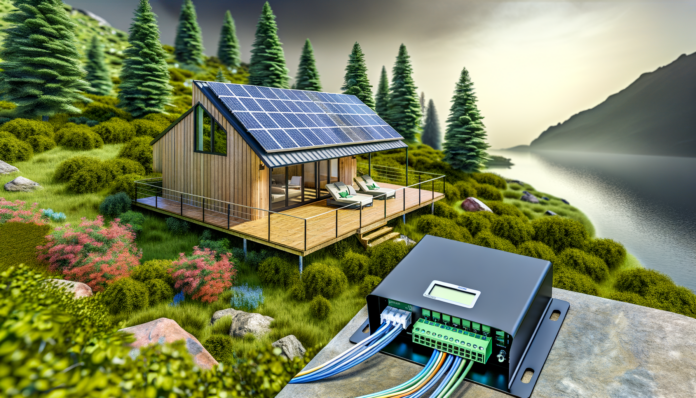Introduction to Charge Controllers
What is a Charge Controller?
A charge controller, also known as a charge regulator or solar battery maintainer, is a crucial component in any solar power system. Its primary function is to manage the charging and discharging of the battery bank, ensuring that the batteries are not overcharged during the day and preventing the stored electricity from flowing back to the solar panels at night. This regulation is essential because the voltage generated by solar panels can be significantly higher than what the batteries can safely handle. For instance, a 12V solar panel can produce between 16 and 20V, which is too high for a 12V battery that gets fully charged at around 14-14.5V. Without a charge controller, this excess voltage can reduce the battery’s lifespan or even cause damage.
Importance of Charge Controllers in Off-Grid Setups
In off-grid solar power systems, the charge controller acts as the brain, managing the flow of electricity to ensure the system operates efficiently and safely. Here are some key functions of a charge controller:
- Overcharge Protection: Prevents the battery from being overcharged, which can lead to overheating and damage.
- Reverse Current Protection: Stops the battery from discharging back into the solar panels at night.
- Load Management: Controls the power drained from the battery by connected appliances, disconnecting them if necessary to prevent overdischarge.
- Voltage Regulation: Adjusts the power sent from the solar array to the battery according to the battery’s state of charge, extending battery life.
- Low-Voltage Disconnect (LVD): Disconnects loads when the battery is low and reconnects them when the battery is sufficiently charged.
These functions are vital for maintaining the health and efficiency of the battery bank, which is the heart of any off-grid solar power system.
Overview of the Article
This article aims to provide a comprehensive guide to understanding and selecting the best charge controller for your off-grid solar power setup. We will cover the following sections:
- Types of Charge Controllers: An in-depth look at Pulse Width Modulation (PWM) and Maximum Power Point Tracking (MPPT) controllers, including a comparison of their features and applications.
- Key Features to Consider: Important factors such as voltage and current ratings, efficiency, durability, ease of installation, and additional features like LCD screens and Bluetooth connectivity.
- Assessing Your Off-Grid Power Needs: How to calculate your energy consumption, size your solar panels and battery bank, and match the right charge controller to your system.
- Installation and Maintenance Tips: A step-by-step installation guide, common mistakes to avoid, and routine maintenance and troubleshooting tips.
- Real-World Applications and Case Studies: Examples of off-grid homes, camping and RV setups, boating and marine applications, and emergency backup systems.
- Conclusion: A recap of key points, final recommendations, and encouragement to explore and invest in solar solutions.
By the end of this article, you will have a thorough understanding of charge controllers and be well-equipped to choose the best one for your off-grid solar power system.
Types of Charge Controllers
Pulse Width Modulation (PWM) Controllers
Pulse Width Modulation (PWM) controllers are a common type of charge controller used in solar power systems. They work by making a direct connection between the solar array and the battery bank, using a series of rapid on-off pulses to regulate the charging process. The frequency and duration of these pulses are adjusted based on the battery’s state of charge. For instance, when the battery is nearly full, the pulses are shorter and less frequent, whereas a more discharged battery receives longer and more frequent pulses.
**Advantages of PWM Controllers:**
- Cost-Effective: PWM controllers are generally less expensive than their MPPT counterparts, making them a budget-friendly option for small-scale solar setups.
- Simplicity: These controllers are simpler in design and easier to install and maintain.
- Reliability: Due to their straightforward design, PWM controllers are often more reliable and have fewer points of failure.
**Disadvantages of PWM Controllers:**
- Lower Efficiency: PWM controllers are less efficient, especially in systems where the solar panel voltage is significantly higher than the battery voltage. This inefficiency can result in a loss of up to 50% of the solar-generated power.
- Interference: The rapid switching can create interference with radio and TV equipment.
PWM controllers are best suited for small off-grid systems, such as those used in RVs, boats, or small cabins, where cost is a significant consideration and the power requirements are relatively low.
Maximum Power Point Tracking (MPPT) Controllers
Maximum Power Point Tracking (MPPT) controllers are more advanced and efficient than PWM controllers. They work by continuously monitoring the output of the solar panels and adjusting the electrical operating point to ensure that the panels are operating at their maximum power point. This allows the system to extract the maximum possible power from the solar panels, even under varying environmental conditions.
**Advantages of MPPT Controllers:**
- Higher Efficiency: MPPT controllers can be 20-30% more efficient than PWM controllers, especially in conditions where the solar panel voltage is much higher than the battery voltage.
- Flexibility: These controllers can handle higher voltage panels and are suitable for larger and more complex solar power systems.
- Adaptability: MPPT controllers perform well in a variety of weather conditions, including cold and cloudy environments, and can optimize performance even with fluctuating light levels.
**Disadvantages of MPPT Controllers:**
- Cost: MPPT controllers are more expensive than PWM controllers, which can be a significant factor for budget-conscious projects.
- Complexity: These controllers are more complex and may require more sophisticated installation and maintenance.
MPPT controllers are ideal for larger off-grid systems, such as those used in homes, commercial installations, or any application where maximizing energy efficiency is crucial.
Comparison of PWM and MPPT Controllers
When deciding between PWM and MPPT controllers, several factors should be considered:
**System Size:**
- PWM: Best for smaller systems with lower power requirements, typically up to 150W.
- MPPT: Suitable for larger systems with higher power needs, often above 150W.
**Voltage Compatibility:**
- PWM: The solar panel voltage should match the battery voltage to avoid significant power loss.
- MPPT: Can handle higher voltage panels and step down the voltage efficiently, making them more versatile.
**Efficiency:**
- PWM: Less efficient, especially in systems where the panel voltage is much higher than the battery voltage.
- MPPT: More efficient, capable of extracting maximum power from the solar panels under various conditions.
**Cost:**
- PWM: More affordable, making them suitable for budget-limited projects.
- MPPT: Higher initial cost but can result in long-term savings due to increased efficiency.
**Environmental Conditions:**
- PWM: Performs adequately in warm and sunny conditions.
- MPPT: Excels in colder and cloudy conditions, as well as in environments with fluctuating light levels.
In summary, the choice between PWM and MPPT controllers depends on the specific requirements of your off-grid solar power system. For small, budget-conscious projects, PWM controllers offer a cost-effective and reliable solution. For larger systems where efficiency and adaptability are paramount, MPPT controllers provide superior performance and long-term benefits.
Key Features to Consider
When selecting a charge controller for your off-grid solar setup, several key features must be considered to ensure optimal performance and longevity of your system. Below, we delve into the most critical aspects to keep in mind.
Voltage and Current Ratings
The voltage and current ratings of a charge controller are fundamental to its compatibility with your solar power system. The controller must match the voltage of your solar array and battery bank. Common voltage ratings include 12V, 24V, and 48V. Additionally, the current rating should be sufficient to handle the maximum current output from your solar panels. Overloading a charge controller can lead to system failure, so always ensure the controller can handle at least 25% more current than your system’s peak output.
Efficiency and Performance
Efficiency is a crucial factor, especially in off-grid systems where maximizing energy capture is essential. MPPT (Maximum Power Point Tracking) controllers are generally more efficient than PWM (Pulse Width Modulation) controllers, often providing 20-30% more energy from the same solar array. MPPT controllers adjust the input voltage to harvest the maximum power from the solar panels, making them ideal for larger systems or those with higher voltage arrays.
Durability and Weather Resistance
Off-grid setups are often exposed to harsh environmental conditions. Therefore, the durability and weather resistance of a charge controller are vital. Look for controllers with robust, weatherproof enclosures rated at least IP65, which can withstand dust and water ingress. Additionally, controllers with built-in protections against overcharging, over-discharging, and short circuits will enhance the longevity and reliability of your system.
Ease of Installation and Use
The ease of installation and user-friendliness of a charge controller can significantly impact your overall experience. Controllers with clear, comprehensive manuals and straightforward wiring diagrams simplify the installation process. User-friendly interfaces, such as intuitive buttons and clear indicator lights, make it easier to monitor and adjust settings. Some advanced models even offer remote monitoring capabilities, allowing you to manage your system from a distance.
Additional Features
Modern charge controllers come with a variety of additional features that can enhance their functionality and ease of use:
- LCD Screens: Provide real-time data on system performance, including battery voltage, charging current, and error messages.
- Bluetooth Connectivity: Allows for wireless monitoring and control via a smartphone app, offering convenience and flexibility.
- Temperature Compensation: Adjusts the charging parameters based on ambient temperature, optimizing battery performance and lifespan.
- Load Control: Some controllers can manage DC loads directly, turning them off to prevent battery over-discharge.
In summary, selecting the right charge controller involves balancing several factors, including voltage and current ratings, efficiency, durability, ease of use, and additional features. By carefully considering these aspects, you can ensure that your off-grid solar power system operates efficiently and reliably.
Assessing Your Off-Grid Power Needs
Calculating Your Energy Consumption
Understanding your energy consumption is the first step in designing an effective off-grid solar power system. Begin by listing all the electrical devices you plan to use, including their power ratings (in watts) and estimated usage time (in hours per day). For example:
- Refrigerator: 150W, 24 hours/day
- LED Lights: 10W each, 5 hours/day
- Laptop: 50W, 4 hours/day
Calculate the daily energy consumption for each device by multiplying the power rating by the usage time. Sum these values to get the total daily energy consumption in watt-hours (Wh). For instance:
- Refrigerator: 150W * 24h = 3600Wh
- LED Lights: 10W * 5h * 5 lights = 250Wh
- Laptop: 50W * 4h = 200Wh
Total daily energy consumption = 3600Wh + 250Wh + 200Wh = 4050Wh.
Sizing Your Solar Panels and Battery Bank
Once you know your daily energy consumption, you can size your solar panels and battery bank accordingly.
Solar Panels: To determine the number of solar panels needed, consider the average peak sun hours in your location. For example, if you receive 5 peak sun hours per day, and you need to generate 4050Wh daily, you can use the following formula:
Required Solar Panel Capacity (W) = Total Daily Energy Consumption (Wh) / Peak Sun Hours (h)
In this case: 4050Wh / 5h = 810W. If you choose 200W panels, you would need approximately 4 panels (810W / 200W per panel).
Battery Bank: To ensure you have enough stored energy, consider the number of days of autonomy you need (days without sun). For example, if you want 2 days of autonomy:
Required Battery Capacity (Wh) = Total Daily Energy Consumption (Wh) * Days of Autonomy
In this case: 4050Wh * 2 = 8100Wh. If you use 12V batteries, convert Wh to amp-hours (Ah):
Required Battery Capacity (Ah) = Total Battery Capacity (Wh) / Battery Voltage (V)
8100Wh / 12V = 675Ah. If you choose 200Ah batteries, you would need approximately 4 batteries (675Ah / 200Ah per battery).
Matching Charge Controllers to Your System
Selecting the right charge controller is crucial for the efficiency and longevity of your off-grid system. The charge controller must be compatible with both your solar panels and battery bank.
Voltage and Current Ratings: Ensure the charge controller can handle the total voltage and current from your solar panels. For instance, if you have 4 panels in series, each with a voltage of 20V, the total voltage would be 80V. The charge controller should support this voltage. Similarly, if each panel produces 10A, the total current would be 40A, so the charge controller should handle at least this current.
Type of Charge Controller: Choose between Pulse Width Modulation (PWM) and Maximum Power Point Tracking (MPPT) controllers. MPPT controllers are generally more efficient, especially in systems with higher voltage panels or in variable weather conditions.
Additional Features: Consider features like LCD screens for monitoring, Bluetooth connectivity for remote management, and temperature sensors for optimal battery charging.
By carefully assessing your energy needs, sizing your solar panels and battery bank, and selecting the appropriate charge controller, you can create a reliable and efficient off-grid solar power system tailored to your specific requirements.
Installation and Maintenance Tips
Step-by-Step Installation Guide
Installing a charge controller in your off-grid solar setup is a critical step to ensure the longevity and efficiency of your system. Follow these steps for a successful installation:
1. **Choose the Right Location**: Select a cool, dry place for the charge controller, away from direct sunlight and moisture. Ensure it is easily accessible for monitoring and maintenance.
2. **Mount the Charge Controller**: Secure the charge controller to a stable surface using the mounting brackets provided. Ensure it is mounted vertically to allow for proper ventilation.
3. **Connect the Battery**: Always connect the battery to the charge controller first. Use appropriate gauge wires and ensure the connections are tight and secure. This step is crucial to prevent any damage to the controller.
4. **Connect the Solar Panels**: Next, connect the solar panels to the charge controller. Ensure the panels are wired correctly (series or parallel) based on your system design. Double-check the polarity to avoid any reverse connections.
5. **Connect the Load (if applicable)**: If your charge controller has a load output, connect your DC loads to this terminal. This allows the controller to manage the power distribution efficiently.
6. **Power On and Configure**: Turn on the charge controller and configure the settings according to your battery type and system requirements. Refer to the user manual for specific instructions.
Common Installation Mistakes to Avoid
Avoiding common mistakes during installation can save you time and prevent potential damage to your system:
– **Incorrect Wiring**: Double-check all connections for correct polarity and secure fittings. Incorrect wiring can lead to short circuits or damage to the charge controller.
– **Inadequate Wire Sizing**: Use wires of appropriate gauge to handle the current. Undersized wires can overheat and cause voltage drops, reducing system efficiency.
– **Poor Ventilation**: Ensure the charge controller is mounted in a well-ventilated area. Overheating can reduce the lifespan and performance of the controller.
– **Skipping the Battery Connection First**: Always connect the battery before the solar panels. This step is crucial to prevent damage to the charge controller.
– **Ignoring Manufacturer Instructions**: Follow the manufacturer’s guidelines and recommendations for installation and configuration. Each charge controller may have specific requirements.
Routine Maintenance and Troubleshooting
Regular maintenance and prompt troubleshooting can keep your off-grid solar system running smoothly:
– **Visual Inspections**: Regularly inspect the charge controller and connections for any signs of wear, corrosion, or damage. Address any issues immediately to prevent further problems.
– **Clean Connections**: Ensure all electrical connections are clean and tight. Loose or corroded connections can lead to poor performance and potential safety hazards.
– **Monitor Performance**: Use the charge controller’s display or monitoring app to keep an eye on system performance. Look for any irregularities in voltage, current, or temperature readings.
– **Firmware Updates**: Check for firmware updates from the manufacturer. Updating the firmware can improve performance and add new features.
– **Troubleshooting Common Issues**:
– **No Power Output**: Check all connections and ensure the battery is properly connected and charged.
– **Overheating**: Ensure the controller is in a well-ventilated area and not exposed to direct sunlight.
– **Erratic Readings**: Verify all connections and check for any loose or corroded wires.
By following these installation and maintenance tips, you can ensure that your charge controller operates efficiently and reliably, providing you with a stable and sustainable off-grid power solution.
Real-World Applications and Case Studies
Off-Grid Homes
Off-grid homes are one of the most common applications for charge controllers. These homes rely entirely on renewable energy sources, such as solar panels, to meet their electricity needs. Charge controllers play a crucial role in these setups by regulating the voltage and current from the solar panels to the battery bank, ensuring efficient and safe charging.
For instance, a family living in a remote cabin in the mountains might use a solar power system with an MPPT (Maximum Power Point Tracking) charge controller. The MPPT controller optimizes the power output from the solar panels, even under varying weather conditions, ensuring that the battery bank is charged efficiently. This setup allows the family to have a reliable power source for lighting, refrigeration, and other essential appliances, even when they are far from the grid.
Camping and RV Setups
Camping and RV setups are another popular application for charge controllers. These mobile setups often use solar panels to provide power for lights, small appliances, and electronic devices. Charge controllers are essential in these systems to prevent overcharging and to manage the power flow from the solar panels to the batteries.
For example, an avid camper might install a PWM (Pulse Width Modulation) charge controller in their RV. The PWM controller is cost-effective and works well with smaller solar setups, making it ideal for camping applications. This setup allows the camper to enjoy the convenience of electricity for cooking, lighting, and charging devices while exploring remote locations.
Boating and Marine Applications
Boating and marine applications also benefit significantly from the use of charge controllers. Boats often use solar panels to supplement their power needs, reducing reliance on the engine or shore power. Charge controllers ensure that the batteries are charged safely and efficiently, extending their lifespan and improving overall system performance.
For instance, a sailboat equipped with solar panels and an MPPT charge controller can harness solar energy to power navigation systems, lights, and communication devices. The MPPT controller maximizes the energy harvested from the solar panels, even in low-light conditions, ensuring that the boat’s batteries remain charged and ready for use during long voyages.
Emergency Backup Systems
Emergency backup systems are critical in areas prone to power outages or natural disasters. These systems often use solar panels and batteries to provide a reliable source of electricity when the grid is down. Charge controllers are vital in these setups to manage the charging process and protect the batteries from damage.
For example, a community center in a hurricane-prone region might install a solar power system with an MPPT charge controller. The MPPT controller ensures that the batteries are charged efficiently, even during cloudy days, providing a reliable backup power source during emergencies. This setup can power essential services such as lighting, communication equipment, and medical devices, ensuring the community’s safety and well-being during power outages.
In conclusion, charge controllers are indispensable in various real-world applications, from off-grid homes and camping setups to boating and emergency backup systems. By ensuring efficient and safe charging of batteries, charge controllers play a crucial role in harnessing renewable energy and providing reliable power in diverse settings.
Conclusion
Recap of Key Points
As we have explored throughout this article, charge controllers are indispensable components in off-grid solar power systems. They regulate the flow of electrical energy from solar panels to batteries, ensuring optimal charging and preventing overcharging, which can significantly extend the lifespan of your batteries. We delved into the two main types of charge controllers: **Pulse Width Modulation (PWM)** and **Maximum Power Point Tracking (MPPT)**. While PWM controllers are cost-effective and suitable for smaller systems, MPPT controllers offer higher efficiency and are ideal for larger, more complex setups. Additionally, we discussed the key features to consider when selecting a charge controller, such as voltage and current ratings, efficiency, durability, ease of installation, and additional features like LCD screens and Bluetooth connectivity.
Final Recommendations
When choosing a charge controller for your off-grid setup, it is crucial to assess your specific energy needs and system requirements. Here are some final recommendations to guide your decision:
1. **Evaluate Your Energy Consumption**: Calculate your daily energy usage to determine the size of your solar panels and battery bank.
2. **Choose the Right Type**: For smaller, budget-conscious systems, a PWM controller may suffice. For larger systems requiring high efficiency, an MPPT controller is the better choice.
3. **Consider Key Features**: Look for controllers with appropriate voltage and current ratings, high efficiency, and robust durability. Additional features like LCD screens and remote monitoring can enhance usability.
4. **Plan for the Future**: If you anticipate expanding your system, opt for a charge controller that can handle increased capacity and additional features.
Encouragement to Explore and Invest in Solar Solutions
Investing in solar power and the right charge controller for your off-grid setup is not just a step towards energy independence; it is also a commitment to sustainability and environmental stewardship. Solar energy is a renewable resource that reduces reliance on fossil fuels and decreases carbon footprints. By choosing to explore and invest in solar solutions, you are contributing to a greener future while also enjoying the benefits of reliable, off-grid power.
Whether you are powering an off-grid home, a camping setup, a marine application, or an emergency backup system, the right charge controller can make a significant difference in the efficiency and longevity of your solar power system. We encourage you to take the time to research, plan, and invest in a charge controller that best fits your needs. The journey towards sustainable energy is a rewarding one, and with the right tools and knowledge, you can achieve a reliable and efficient off-grid power system.






